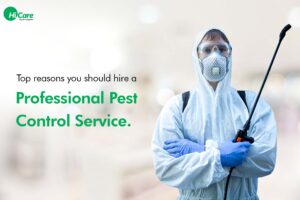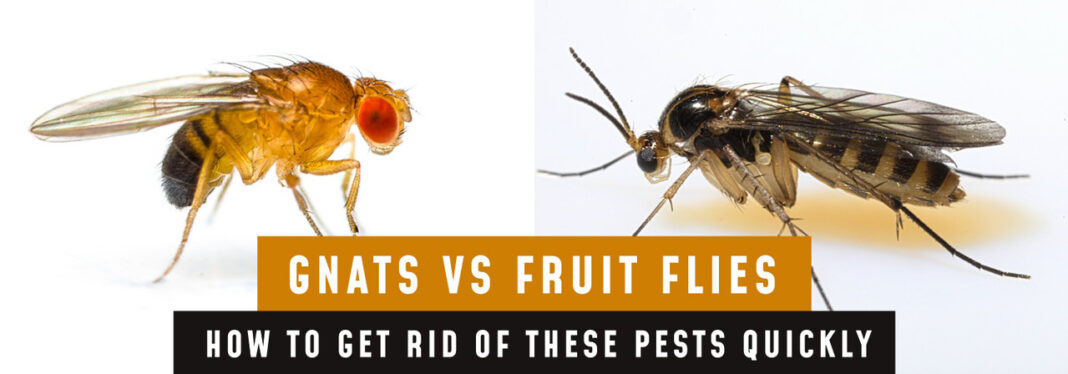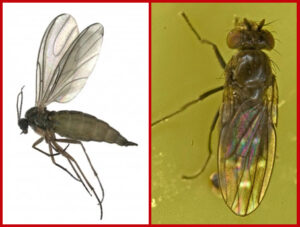How to Identify and Control Your Infestation
Both fruit flies and fungus gnats are common nuisance insects that can invade your home, causing frustration and confusion. They have similar habits and appearances, which can lead to misidentification. However, understanding the differences between these pests is essential for effective control and prevention. Here’s how to distinguish between fruit flies and gnats, identify their habitats, and manage infestations.
The Difference Between Fungus Gnats and Fruit Flies
Appearance
Fruit Flies
- Size: About 1/8 inch (3-4 mm) long.
- Color: Typically tan or light brown, with distinctive red eyes.
- Shape: Rounded body with short antennae.
Fungus Gnats
- Size: Similar to fruit flies, around 1/8 inch (3-4 mm) in length.
- Color: Usually darker, often black or dark brown.
- Shape: Slender bodies with long legs and long antennae.
Fruit Fly vs. Gnat Habitat
Fruit Flies
Fruit flies are primarily attracted to areas with fermenting or decaying organic matter. They are commonly found:
- Around Overripe Fruits and Vegetables: Fruit flies are often seen hovering around fruit bowls, especially if the fruits are overripe or beginning to rot.
- Near Trashcans: They are drawn to the smell of decaying food and organic waste in trashcans.
- In Dirty Drains: Fruit fly larvae thrive in the moist, organic buildup found in dirty drains, making sinks a common breeding ground.
Fungus Gnats
Fungus gnats, on the other hand, prefer moist environments rich in organic matter. They are typically found:
- In Garden Soil: Fungus gnats often nest in the soil of outdoor gardens where they can feed on organic material.
- Around Indoor Potted Plants: They are commonly found around indoor plants, especially when the soil is kept consistently moist.
- In Moist Soil: Any area with damp, organic-rich soil is attractive to fungus gnats, including plant pots and garden beds.
Controlling Fruit Flies vs. Gnats
Fruit Flies
Fruit flies reproduce rapidly and can become a major nuisance if not controlled quickly. Here are some effective methods to control fruit flies:
- Cleanliness: Keep kitchen areas clean and free of decaying food.
- Storage: Store fruits and vegetables in the refrigerator or in sealed containers.
- Waste Management: Regularly empty trash cans and clean drains to remove organic buildup.
- Traps: Use vinegar traps or commercial fruit fly traps to capture adults.
Fungus Gnats
Fungus gnats not only annoy homeowners but can also damage plant roots. Here are some strategies to control fungus gnats:
- Soil Management: Allow the soil to dry out between waterings to reduce breeding grounds.
- Plant Care: Remove any dead plant material and use well-draining soil.
- Indoor Environment: Use sticky traps near houseplants to catch adults.
- Fungicides: Consider using a soil fungicide if fungus is contributing to the problem.
Professional Assistance
Both fruit flies and gnats can reproduce rapidly, making quick removal a priority. Besides annoying homeowners with their large numbers, fungus gnats can damage plant roots, while fruit flies may spread diseases through contaminated food. Because each insect poses its own issues, control methods must be tailored to the specific pest.
For those struggling with fruit fly or gnat problems, turning to pest control experts like Orkin can provide effective and professional assistance. They have the expertise and tools necessary to manage and eliminate these pests, ensuring a healthier and more comfortable living environment.
Fruit Flies, Gnats, or Drain Flies: Identifying Tiny Pests in Your Home
When you notice tiny flies buzzing around your house, it can be tempting to lump them all together as just “tiny flies.” However, the pests flying around your kitchen and bathroom drains can be very different. Identifying exactly which type of insect you are dealing with—fruit flies, fungus gnats, or drain flies—is essential for effectively controlling and eliminating them. Here’s how to tell them apart.
What Do Fruit Flies Look Like?
Without a doubt, fruit flies are the most common flying insects that will pester you in the kitchen. They are attracted to fresh and decomposing fruit as well as sugary juices and alcohol.
Characteristics of Fruit Flies
- Colors: The two most common fruit flies are the Red-Eyed Fruit Fly and the Dark-Eyed Fruit Fly. Both have striped abdomens. As their names suggest, the Red-Eyed Fruit Fly has red eyes, while the Dark-Eyed Fruit Fly has black eyes.
- Size: Red-Eyed Fruit Flies are about 1/8 inch (3 mm) long. Dark-Eyed Fruit Flies are slightly larger, at about 3/16 inch (4-5 mm) long.
- Body Type: Fruit flies have a body shape similar to a house fly but are much smaller.
- Where to Find Them: Fruit flies may be buzzing around your fruit bowl, inside a trash receptacle, in a recycling bin, or in your drain or garbage disposal.
Controlling Fruit Flies
The best way to get rid of fruit flies is to keep your kitchen and garbage receptacles clean of any accumulated debris that may attract them. This includes:
- Thoroughly rinsing out beverage containers.
- Using fruit quickly or placing it in the refrigerator.
- Sealing garbage cans and removing refuse regularly from the area.
Where Do Fruit Flies Lay Their Eggs?
Fruit flies lay their eggs on fruit that has been left out too long and started to rot or inside the drains of kitchen sinks where old food has collected.
What Do Gnats Look Like?
If you spot a swarm of bugs flitting above a houseplant, you probably have fungus gnats instead of fruit flies. Fungus gnat larvae and pupae prefer moist soil to protect them as they develop. Before they progress to adult form, they can severely damage the root system of your potted plants.
Characteristics of Fungus Gnats
- Colors: Adults are brown or black with light-colored legs.
- Size: Adult gnats are less than 1/8 inch (3 mm) long. Their larvae and pupae are about the same size.
- Body Type: Although technically flies, fungus gnats have a mosquito-like appearance.
- Where to Find Them: Fungus gnats will be spotted flying close to your potted plants and will show little interest in going anywhere else as long as there is moist soil available.
How to Identify Drain Flies
These hairy bugs are another common kitchen pest. They thrive in dark, damp conditions and often find an ideal home inside a drain, including floor drains, sink drains, sink overflows, or any area open to plumbing. Although they don’t bite, their presence can aggravate asthma in some people.
Characteristics of Drain Flies
- Colors: Light gray or tan with a dark border around the wings.
- Size: About 1/8 inch (3 mm) long.
- Body Type: Moth-like with fuzzy bodies and antennae.
- Where to Find Them: Drain flies breed inside of drains, often laying eggs in the sludge that accumulates inside. Adults will clumsily fly out of the drain and land nearby on walls and ceilings.
Controlling Drain Flies
To manage drain fly infestations, focus on cleaning and maintaining your drains. This includes:
- Regularly cleaning drains with a brush and a drain cleaner.
- Ensuring that drains are free of organic buildup and debris.
- Keeping the area around drains dry and free of excess moisture.
-
Fruit Flies vs. Gnats: What You Need to Know
When it comes to dealing with pesky flying insects in your home or business, distinguishing between fruit flies and gnats can be crucial. Though they may appear similar to the naked eye, a closer examination reveals notable differences in their appearance, life cycles, and habitats. This article will explore how to identify fruit flies and gnats, where they come from, how to prevent infestations, and effective methods for removal.
What Do Fruit Flies and Gnats Look Like?
Fruit Flies
- Size: Adult fruit flies are typically around 1/8 inch long.
- Color: They come in various shades, including tan, brown-yellow, or brown-black.
- Eyes: Most fruit flies have distinct red eyes, making them easily recognizable.
- Antennae: Fruit fly antennae are shorter compared to those of gnats.
Gnats
Gnats encompass several species, with fungus gnats being a common type.
- Size: Adult gnats are generally slightly smaller than fruit flies, often measuring around 1/16 to 1/8 inch long.
- Color: They are usually dark, ranging from brown to black, often with long, slender legs.
- Appearance: Gnats have longer antennae than fruit flies, giving them a more elongated look.
Life Cycle: Fruit Fly vs. Gnat
Fruit Flies
- Egg Stage: Fruit flies lay their eggs on fermenting fruits, vegetables, or in containers of rotting produce. They can also infest garbage disposals.
- Larvae Stage: After a few days, larvae hatch from the eggs and begin feeding on the decaying organic matter.
- Pupae Stage: The larvae undergo several molts and eventually enter a pupa stage.
- Adult Stage: Once the pupal stage is complete, they emerge as adults and begin mating shortly after.
Fungus Gnats
- Egg Stage: Fungus gnats lay their eggs in moist soil or decaying organic matter.
- Larvae Stage: The larvae, which are typically transparent and worm-like, feed on fungi and plant roots.
- Pupae Stage: After a short period, they transform into pupae.
- Adult Stage: In warm conditions, they can mature quickly, leading to rapid population growth.
Where Do Fruit Flies and Gnats Come From?
Fruit Flies
Fruit flies are commonly found in areas with fresh and decomposing fruits and vegetables. Common sources include:
- Homes: They thrive in kitchens, particularly around fruit bowls and garbage cans.
- Restaurants and Bars: Establishments with exposed fruit, beer tap spigots, and soda drains are at risk of infestations.
- Garden Produce: Freshly picked fruits and vegetables can harbor fruit fly eggs, so inspect them carefully before bringing them indoors.
Gnats
Gnats, particularly fungus gnats, are primarily found outdoors but can also invade homes through various means:
- Moist Environments: They are often found in dirty drains or areas with damp soil.
- Indoor Plants: Gnats can enter your home through potted plants, especially if the soil is overwatered.
- Open Doors and Windows: Gnats are attracted to light and can easily enter when doors are opened.
How to Prevent Fruit Flies and Gnats
Preventing infestations of fruit flies and gnats is essential to maintaining a pest-free environment. Here are some practical tips:
Preventing Fruit Flies
- Dispose of Rotten Fruit: Take any overripe or rotten fruit outside promptly.
- Check Seals on Containers: Ensure that all fruit and vegetable containers have proper seals to prevent access.
- Clean Up Spills: Clean up spills from beverages, particularly fruit juices or alcohol, immediately to remove attractive residues.
Preventing Gnats
- Use Screens: Ensure windows and doors are fitted with screens that are free from holes to keep gnats out.
- Change Outdoor Lighting: Consider replacing white porch lights with yellow lights, which are less attractive to flying insects.
- Properly Water Plants: Avoid overwatering indoor plants, and ensure that pots have adequate drainage.
How to Get Rid of Fruit Flies and Gnats
If you notice an increase in fruit flies, gnats, or other flying insects in your home or business, it’s crucial to take action quickly. Here are some effective removal methods:
DIY Methods
- Traps: Create simple traps using apple cider vinegar or wine in a bowl covered with plastic wrap. Poke small holes in the wrap to attract and capture fruit flies.
- Sticky Traps: Use yellow sticky traps to capture flying insects, including gnats.
- Cleaning: Regularly clean drains and remove organic matter from kitchens and bathrooms.
Professional Pest Control

- If infestations persist, reach out to a pest control professional. Experts can assess the situation and provide targeted treatments to effectively eliminate fruit flies and gnats. Companies like Ehrlich specialize in identifying and removing these pests, ensuring your space remains comfortable and pest-free.
Conclusion
While fruit flies and gnats may seem similar, understanding their differences can help you manage and prevent infestations effectively. By taking preventive measures and knowing how to identify these pests, you can minimize the risk of encountering these nuisances in your home or business. If an infestation does occur, don’t hesitate to contact a pest control professional to address the problem quickly and efficiently.





